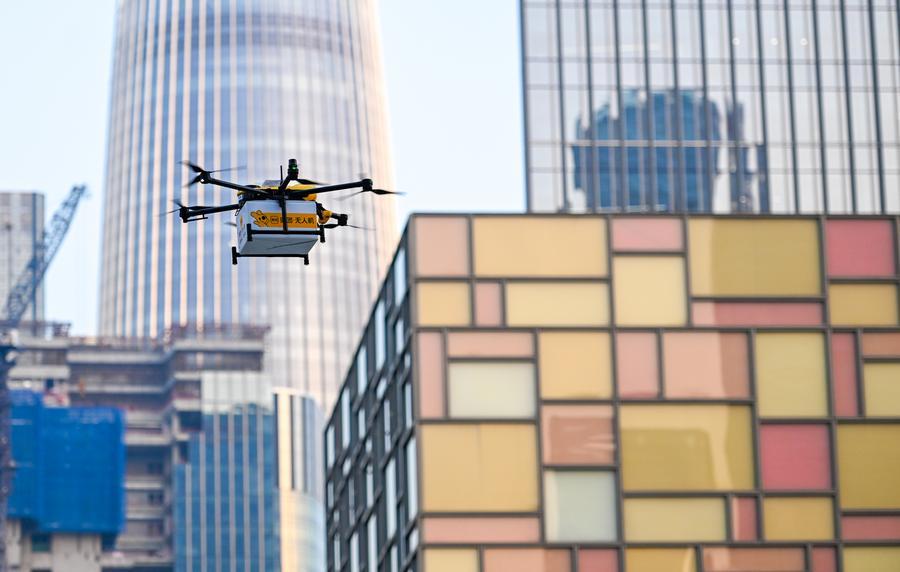Xinhua | July 19, 2024

An unmanned aerial vehicle (UAV) carrying food package is seen at the Houhai area in Shenzhen, south China's Guangdong Province, Nov. 24, 2023. (Xinhua/Mao Siqian)
Instead of checking her mailbox frequently for her university admission letter, high school graduate Wang Yunyi received it up from the sky.
On Monday morning, an unmanned aerial vehicle (UAV) for the first time delivered four college admission letters issued by the South China University of Technology to the hands of four students in the Chinese city of Guangzhou. The drone trip took about 30 minutes, covering 25 km, forming a new scenario for China's UAV application.
"I was amazed to see my admission letter sent by a drone. It was like a movie scene coming to real life," said Wang.
Guangzhou Post, the drone operator, has been delivering college admission letters for over 40 years, handling about 550,000 letters annually.
"In the future, more students can experience technological advancement with their admission letters sent by drones," said Zou Liwen, a manager at Guangzhou Post.
In recent years, drones have become increasingly common in video clip productions, express and meal deliveries and fleet shows as China strives to expand its low-altitude economy, which was included in the country's government work report for the first time in March this year.
Data from the Civil Aviation Administration of China (CAAC) show that China had 1.27 million registered drones by the end of 2023, up 32.2 percent compared with the previous year. Civilian drones accumulated 23.11 million flight hours in 2023, representing an 11.8 percent year-on-year growth.
A technician checks a UAV at Liaoning Dazhuang UAV Technology Co., Ltd. in Shenyang, northeast China's Liaoning Province, May 13, 2024. (Xinhua/Li Gang)
Phoenix Wings, a cargo drone company under China's delivery giant SF Express, initiated the interprovincial drone-delivery service for fresh fruit across the Qiongzhou Strait in late May.
This new mode of transport is 70 percent quicker and 30 percent cheaper than conventional cross-sea transport, enhancing the freshness of the lychees and the economic benefits on all sides.
CAAC data shows that the scale of China's low-altitude economy exceeded 500 billion yuan (about 70 billion U.S. dollars) in 2023, and is expected to reach 2 trillion yuan by 2030.
More drones in the sky have also expanded the spectrum of applications. While many parts of China are battling floods in the summer, UAVs are seen at the forefront, patrolling embankments and delivering disaster relief supplies in water-stranded areas.
In central China's Hunan Province, where a dike section breached earlier this month at China's second-largest freshwater lake of Dongting, fire and rescue teams in the province deployed a fleet of 47 UAVs for flood control and disaster relief work.
Liang Shixin, a member of the telecommunication team for emergency response at the provincial fire and rescue headquarters, said he operated a UAV a dozen times a day as a complementary means to monitor the embankments.
Unlike conventional drones that are mainly equipped with cameras, the UAV has thermal infrared and lidar sensors, being capable of quickly scanning embankments to capture signs of pipe bursts and leakage hazards even in the darkness, said Liang.
The Wing Loong-2 large unmanned aerial vehicle (UAV) takes off from an airport in the city of Zigong, southwest China's Sichuan Province, March 18, 2024. (Aviation Industry Corporation of China/Handout via Xinhua)
Incomplete statistics showed that China had more than 2,300 companies engaged in civilian drone development by the end of 2023, with over 1,000 drone types in mass production. In 2023 alone, over 3.17 million civilian drones were delivered in China, and the general aviation manufacturing industry generated an output exceeding 51 billion yuan, an increase of nearly 60 percent year on year.
In April, the Chinese drone maker EHang Holdings Limited obtained the production certificate for its passenger-carrying autonomous aerial vehicle system from the CAAC. It is the first production certificate issued in China for an autonomous passenger drone and also the first one in the global electric vertical takeoff and landing industry.
He Tianxing, vice president of the company, noted that the expansion of the low-altitude economy will further drive the development of upstream and downstream industries, such as new infrastructure, spare parts, energy storage, cultural tourism and education.



